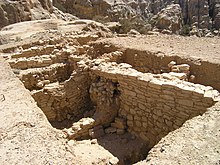Ba'ja
Coordinates: 30 ° 24 ′ 49 ″ N , 35 ° 27 ′ 41 ″ E
Ba'ja ( Arabic بعجة Baʿdscha , DMG Baʿǧa ) is a Neolithic village about 14 km north of Petra in Jordan . The settlement is dated to the Pre-Ceramic Neolithic B and is around 9,000 years old. Ba'ja lies at an altitude of around 1,160 meters between steep sandstone formations and is only accessible with ladders via a climbing path through a narrow, steep gorge. Near the entrance to the Siq of Ba'ja is the site of Ba'ja I , an Islamic settlement with 2-3 layers of settlement,preceded bya Nabatean outpost.
Houses
The maximum usable settlement area of the hilltop settlement of Ba'ja, for which 600 inhabitants are assumed, was 1.2 to 1.5 hectares. For this reason, the houses were built right up to the surrounding steep slopes (up to 45 °) and close to each other. Many houses had more than one floor, with the floors being connected by an internal staircase. The walls of the buildings were up to 4.20 meters thick. In addition, the houses mostly had a cellar and were often renewed, whereby the settlement plan also changed.
Numerous stone axes and stone bowls were ritually buried between the walls of the houses and under the floors. Human and animal remains have also been found in the same context.
Ossuary
In a 0.6 m² room with remains of a wall painting in fresco technique , which shows abstract motifs and geometric figures, were the bones of three adults and nine small children, in whom no diseases could be proven that led to their death. In the burials, which were not at the same time, the deceased was placed in the middle of the room and the bones of previous burials pushed aside. Although the grave was already disrupted in the Neolithic, numerous artificial pearls , nine arrowheads , a broken flint dagger , a mother-of-pearl ring and another piece of mother-of-pearl jewelry were found under the skull of a newborn baby. There was red ocher throughout the grave, which caused the bones and finds to turn red . The analysis of the grave did not reveal any indications of a special status of the buried. Presumably they are the deceased of a large family, whereby the many child skeletons could indicate a high child mortality .
Social structure and economy
A flat hierarchy is assumed for Ba'ja , in which decisions are made by consensus of the heads of families. The existence of a village head cannot be ruled out.
Many sandstone rings from local production were found within the settlement area, which appeared in all of central Jordan at this time and possibly represented an object of exchange, which should indicate a certain wealth of the place. Since such stone rings and their precursors were found in all households, it can be assumed that their production was organized within the families.
Food production was done mainly by livestock farming , hunting, whereby furs of leopards , foxes and closing remote incurred.
literature
- Hans Georg K. Gebel, JM Starck: Investigations into the stone age of the Petra area (Early Holocene research). A preliminary report on the 1984 campaigns. Annual of the Department of Antiquities of Jordan 29, 1985, pp. 89-114.
- Hans Georg K. Gebel: The New Stone Age in the Petra area. In: M. Lindner (Ed.): Petra. New excavations and discoveries. Delp, Munich / Bad Windsheim 1986, pp. 273-308.
- Hans Georg K. Gebel, Hans-Dieter Bienert: The 1997 Season at Ba'ja, Southern Jordan. Neo-Lithics 3/97, ex oriente, Berlin 1997, pp. 14-18.
- Hans Georg K. Gebel, Hans-Dieter Bienert: Ba'ja hidden in the Petra Mountains. Preliminary results of the 1997 investigations. In: HGK Gebel, Z. Kafafi, GO Rollefson (Ed.): The Prehistory of Jordan, II. Perspectives from 1997. Studies in Early Near Eastern Production, Subsistence, and Environment 4, ex oriente, Berlin 1997, p. 221– 262.
- Hans Georg K. Gebel, Bo Dahl Hermansen: Ba'ja hidden in the Petra Mountains, II. Preliminary results of the 1999–2000 investigations. In: H.-D. Bienert, HGK Gebel, R. Neef (Ed.): Central Settlements in Neolithic Jordan. Studies in Early Near Eastern Production, Subsistence, and Environment 5. ex oriente, Berlin 2004.
- Hans-Dieter Bienert, Roland Lamprichs, Dieter Vieweger : Ba'ja. Archeology of a landscape in Jordan. Report on archaeological field research. In: R. Eichmann (Ed.): Excavations and surveys in the Middle East. I Orient-Archäologie 5, M. Leideck, Rahden 2002, pp. 159-214.
Web links
- Project website
- Hans Georg K. Gebel: The Significance of Ba'ja for Early Near Eastern Neolithic Research. Orient & Occident. Newsletter of the German Protestant Institute of Archeology in Amman 8.1, 2003, pp. 17-19
- Hans Georg K. Gebel: Subsistence forms, settlement methods and processes of social change from the akeramischen to the ceramic Neolithic. Part II: Basic features of social change in the Neolithic of the southern Levant. (PDF; 4.6 MB) University of Freiburg, 2002
Individual evidence
- ↑ Ba'ja I excavation results , BAI Wuppertal
- ↑ Hans Georg K. Gebel: Subsistence forms ... (PDF; 4.6 MB) University of Freiburg, 2002, p. 26.
- ↑ Hans Georg K. Gebel: Subsistence forms ... (PDF; 4.6 MB) University of Freiburg, 2002, p. 75 (Fig.)
- ↑ Hans Georg K. Gebel: Subsistence forms ... (PDF; 4.6 MB) University of Freiburg, 2002, pp. 21-22.



